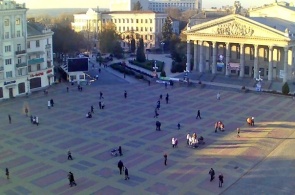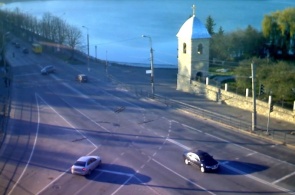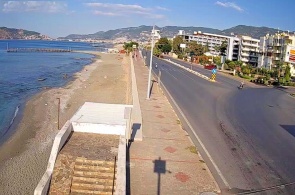Ternopiltakes its basis from the time of the construction on the land of a powerful fortress designed to protect the southeastern borders of the Polish-Lithuanian Commonwealth from Tatar invasions of the Horde. The name of the city on one of the regional versions, comes from the name of its founder, Polish military leader and political figure of Jan Tarnowski, as the city, almost to the middle of the twentieth century was called Tarnopol. There are also other theories and conjecture concerning the etymology of town name. But whatever it was – the city of Ternopil has a distinguished history and a unique cultural heritage. There are a large number of monuments of the fortification and temple architecture and monumental art, many museums, historic natural attractions. Construction founded in 1540, the year of feudal structures and the establishment of the city took eight years. At the end of this period – Ternopil received the Magdeburg law, which, along with favorable economic location of the city contributed to its rapid development. Together with the construction of Ternopil Fort, was created by fill embankment, which served as the bridge on the river Seret, which has been formed by the popular and hitherto Ternopil pond. Despite the inaccessibility of Ternopil walls of the fortress, they could not prevent the numerous looting of the city by the Turks and the Mongols, who burned buildings, devastated land and took the inhabitants into captivity. This continued for a whole century, and in the end – Ternopil fortifications were destroyed, and the castle received a large number of injuries. In the XVII century, Ternopil was built two unique works of religious architecture – Vozdvizhenskiy and Christmas of the Church, which in our days silently reflect the spirit of bygone eras. At the end of the XVIII century, the town passed into the possession of Austria-Hungary, and after coming to power F. Korytowski in the NINETEENTH century, – all fortifications around the Ternopil castle was demolished, and the castle was rebuilt in the Palace, bound by a stone wall with the arms on both sides of the gate. Modern Ternopil, which, like many other cities, has risen from the ashes of the Second world war, today, apart from high culture and national traditions, has a developed infrastructure and tourism. With plenty of hotels and Inns, restaurants and art cafes, malls,parksamusement and water Park, libraries,theatresand cinema halls, radio stations and regional TV channels.
More details
The camera shows the road at the intersection of the Russian and Castle streets in Ternopil. Near this intersection there are several financial institutions, the building of State medical University, the area Will, and, of course, the city's main attraction is Ternopil castle.
Ternopil, Ukraine
15.04.15
The camera shows a view of the intersection of them. Anatoly Zhivov and Metropolitan Andrey Sheptytsky, in the city of Ternopil. Here is a publishing and printing center "Zbruch", named after the river which flows at the borders of Ternopil and Khmelnytsky regions in Ukraine. Also, the intersection is a small market, two shopping complex and bus stop.
Ternopil, Ukraine
15.04.15
The camera shows the bridge over the pond in Ternopil, located in the Park of T. G. Shevchenko, in the city of Ternopil. At the time when the Ternopil castle, the water of the river Seret, which was created by the artificial lake, filled the moat of the fortress walls, and carried many economic functions for the population. In 1987, the Park has gained worldwide significance after the implementation of the world competitions vodomotornomu sport.
Ternopil, Ukraine
15.04.15
One of the most beautiful parks of Ternopil is the hotel. T. G. Shevchenko. There is a wide embankment at the pond formed from the overlap of the river Seret, a large number of green spaces, bridges, and "Island of love" with Grecian temple, near which is located the webcam.
Ternopil, Ukraine
15.04.15
The web camera shows the concert hall under the open sky, situated in the Park of the national revival of the city of Ternopol (Ukraine). There are various contests and song festivals. The stage is an open stage has special acoustics, which plays an important role in ensuring quality sound during the performances.
Ternopil, Ukraine
15.04.15
Theatre square is a beautiful and amazing decoration of Ternopil, which leaves one of the cameras of our site to You first without even leaving Your home or office, able to see with this colorful area is small but not provincial town Ternopil.
Ternopil, Ukraine
24.11.14
The camera opens on a monument to the leader of the Ukrainian nationalist movement OUN – Stepan Bandera, located in the centre paved with paving slabs, the square green geometric flower beds, conifer trees and shrubs.
Ternopil, Ukraine
24.11.14
popular camerasshow all
Sultanahmet or Blue mosque is a work of art of Turkish-Islamic architecture. Its construction began in 1609, the construction work took seven years to a 19-year-old Sultan. The name of the mosque was, due to its interesting and unique finish.
Istanbul, Turkey
Stavanger, a town in the commune of Norway, located in the South-Western part of the country, on the Peninsula, rich in minerals. Tanager combines the influence of foreign organisations such as NATO and oil companies. The camera will shoot the harbour and the promenade of the city.
Stavanger, Norway
A webcam broadcasts the district of Tosmur - quiet location in the Eastern part of Alanya, located only five kilometres from the city centre. Its rural way of life and the beauty of untouched nature attract tourists.
Alanya, Turkey
Shark Island or in English of Shark island, located in the harbour city of Sydney, the suburb of Point Piper. The locals, the natives named the island Boambilly, which translated means Shark island. After all, this name is not casual, because it's mean and looks like a shark fin.
Sydney, Australia
The webcam is installed on site Alva. Tsaghkadzor ski resort town in Armenia. Tsaghkadzor is a beautiful mountainous area among deciduous forests, with a pleasant winter climate, and clean fresh air. The highest point is 1800 meters. The truss type is a classic, divided into three.
Tsakhkadzor, Armenia














